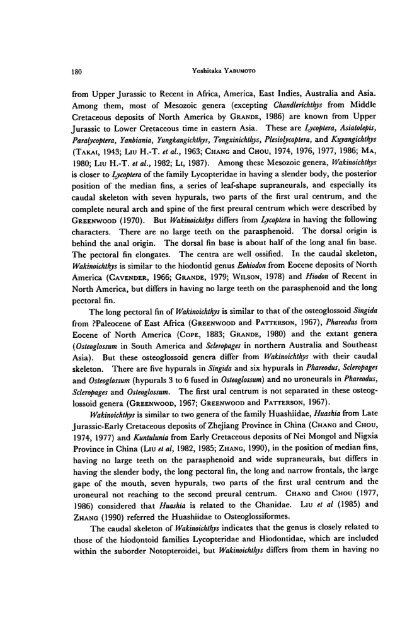Early Cretaceous Freshwater Fish Fauna in Kyushu, Japan
Early Cretaceous Freshwater Fish Fauna in Kyushu, Japan
Early Cretaceous Freshwater Fish Fauna in Kyushu, Japan
You also want an ePaper? Increase the reach of your titles
YUMPU automatically turns print PDFs into web optimized ePapers that Google loves.
180 Yoshitaka Yabumoto<br />
from Upper Jurassic to Recent <strong>in</strong> Africa, America, East Indies, Australia and Asia.<br />
Among them, most of Mesozoic genera (except<strong>in</strong>g Chandlerichthys from Middle<br />
<strong>Cretaceous</strong> deposits of North America by Grande, 1986) are known from Upper<br />
Jurassic to Lower <strong>Cretaceous</strong> time <strong>in</strong> eastern Asia. These are Lycoptera, Asiatolepis,<br />
Paralycoptera, Yanbiania, Yungkangichthys, Tongx<strong>in</strong>ichthys, Plesiolycoptera, and Kuyangichthys<br />
(Takai, 1943; Liu H.-T. et al., 1963; Chang and Chou, 1974, 1976, 1977, 1986; Ma,<br />
1980; Liu H.-T. etal., 1982; Li, 1987). Among these Mesozoicgenera, Wak<strong>in</strong>oichthys<br />
is closer to Lycoptera of the family Lycopteridae <strong>in</strong> hav<strong>in</strong>g a slender body, the posterior<br />
position of the median f<strong>in</strong>s, a series of leaf-shape supraneurals, and especially its<br />
caudal skeleton with seven hypurals, two parts of the first ural centrum, and the<br />
complete neural arch and sp<strong>in</strong>e of the first preural centrum which were described by<br />
Greenwood (1970). But Wak<strong>in</strong>oichthys differs from Lycoptera <strong>in</strong> hav<strong>in</strong>g the follow<strong>in</strong>g<br />
characters. There are no large teeth on the parasphenoid. The dorsal orig<strong>in</strong> is<br />
beh<strong>in</strong>d the anal orig<strong>in</strong>. The dorsal f<strong>in</strong> base is about half of the long anal f<strong>in</strong> base.<br />
The pectoral f<strong>in</strong> elongates. The centra are well ossified. In the caudal skeleton,<br />
Wak<strong>in</strong>oichthys is similar to the hiodontid genus Eohiodon from Eocene deposits ofNorth<br />
America (Cavender, 1966; Grande, 1979; Wilson, 1978) and Hiodon of Recent <strong>in</strong><br />
North America, but differs <strong>in</strong> hav<strong>in</strong>g no large teeth on the parasphenoid and the long<br />
pectoral f<strong>in</strong>.<br />
The long pectoral f<strong>in</strong> of Wak<strong>in</strong>oichthys is similar to that oftheosteoglossoid S<strong>in</strong>gida<br />
from ?Paleocene of East Africa (Greenwood and Patterson, 1967), Phareodus from<br />
Eocene of North America (Cope, 1883; Grande, 1980) and the extant genera<br />
(Osteoglossum <strong>in</strong> South America and Scleropages <strong>in</strong> northern Australia and Southeast<br />
Asia). But these osteoglossoid genera differ from Wak<strong>in</strong>oichthys with their caudal<br />
skeleton. There are five hypurals <strong>in</strong> S<strong>in</strong>gida and six hypurals <strong>in</strong> Phareodus, Scleropages<br />
and Osteoglossum (hypurals 3 to6 fused <strong>in</strong> Osteoglossum) and no uroneurals <strong>in</strong> Phareodus,<br />
Scleropages and Osteoglossum. The first ural centrum is not separated <strong>in</strong> these osteog<br />
lossoid genera (Greenwood, 1967; Greenwood and Patterson, 1967).<br />
Wak<strong>in</strong>oichthys is similar to two genera ofthe family Huashiidae, Huashia from Late<br />
Jurassic-<strong>Early</strong> <strong>Cretaceous</strong> deposits ofZhejiang Prov<strong>in</strong>ce <strong>in</strong> Ch<strong>in</strong>a (Chang and Chou,<br />
1974, 1977) and Kuntulunia from <strong>Early</strong> <strong>Cretaceous</strong> deposits of Nei Mongol and Nigxia<br />
Prov<strong>in</strong>ce <strong>in</strong> Ch<strong>in</strong>a (Liu et al, 1982, 1985; Zhang, 1990), <strong>in</strong> the position ofmedian f<strong>in</strong>s,<br />
hav<strong>in</strong>g no large teeth on the parasphenoid and wide supraneurals, but differs <strong>in</strong><br />
hav<strong>in</strong>g the slender body, the long pectoral f<strong>in</strong>, the long and narrow frontals, the large<br />
gape of the mouth, seven hypurals, two parts of the first ural centrum and the<br />
uroneural not reach<strong>in</strong>g to the second preural centrum. Chang and Chou (1977,<br />
1986) considered that Huashia is related to the Chanidae. Liu et al (1985) and<br />
Zhang (1990) referred the Huashiidae to Osteoglossiformes.<br />
The caudal skeleton of Wak<strong>in</strong>oichthys <strong>in</strong>dicates that the genus is closely related to<br />
those of the hiodontoid families Lycopteridae and Hiodontidae, which are <strong>in</strong>cluded<br />
with<strong>in</strong> the suborder Notopteroidei, but Wak<strong>in</strong>oichthys differs from them <strong>in</strong> hav<strong>in</strong>g no

















